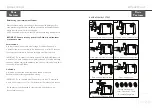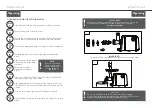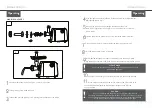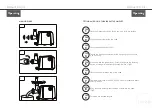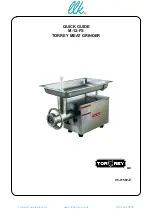
INSTRUCTION | P15
INSTRUCTION | P14
Hints & Tips
• Remove all large pieces of fat from meat before grinding.
• For fatty cuts of meat we recommend that you cut meat into 5cm cubes.
We also recommend using the 8mm cutting plate for fatty cuts of meat.
If the 4mm cutting plate is used and there is excess fat in the meat it can
cause the fat to block the grinder head. This should be avoided.
For lean cuts of meat; cut into strips approximately 15cm long and 5cm
thick or into cubes.
• Remove any bones from meat as this may damage the grinder.
• To make sure that all meat has come through mincing, place a 20cm sheet
of crushed baking paper into the grinder after the last piece of meat.
This will push through any remaining meat and will not damage the grinder.
• If changing cutting plates or changing to another attachment, always ensure
that any meat that is around the fixing ring or blade is removed. This will
• Unused fresh casings must be drained, covered with salt and frozen.
• Sausages should be stored in an airtight container or sealed with cling
film in the refrigerator.
• A good way to make sure that all the sausage mince has come through the
mincer is to break up 1-2 slices of bread and push though mincer, this will
force any remaining mixture into the casing.
• Gentle cooking over medium heat prevents interior from boiling which in turn
bursts the skin, leaking out moisture and flavour. This then produces a hard
textured product.
HITS FOR GRINDING MEAT
HINTS FOR SAUSAGE MAKING CONT.
• Salt is an important component of sausage making. It is responsible for the control
of growth of micro-organisms. It also aids in dissolving the myosin (protein) out of the
muscle fibres which then acts as a glue to bind the meat.
• Freshly made sausages are better when allowed to sit in the refrigerator for a
minimum of 12 hours and for up to 24 hours.
• Fresh sausages are highly perishable products as they do not contain the
preservatives that are present in most store-bought sausages. They should be
cooked within 2-3 days of being made or frozen.
• Ideally, sausages should contain up to 30% fat content to provide a tender and
moist product.
• Sausages should be thoroughly cooked to kill all microbes. Internal temperatures
must reach 70-75°c.
• Intentional piercing of sausage skin releases much needed moisture but
prevents the sausage from possibly splitting and being disfigured.
• Things to look for when making sausages:
Choose good quality ingredients - Fat to meat ratio (30:70) - Spices and
seasoning should be combined in amounts that compliment the meat type.
• Casings (skin) can be purchased from butchers that supply your fresh meat.
If preserved in salt, it should be soaked in lukewarm
HINTS FOR SAUSAGE MAKING
Hints & Tips
Cleaning
When you have completed grinding, unplug the meat grinder from the power outlet.
Ensure that all accessories and attachments are washed thoroughly with hot, soapy
water.
IMPORTANT:
Do not place any parts of the Grinder in a dishwasher.
To remove meat that is stuck in the fine and medium cutting plates, use hot, soapy
water and a scrubbing brush, clean thoroughly.
Ensure that all attachments are thoroughly cleaned and free of
meat to prevent contamination. Then dry thoroughly before storing.
NOTE:
Always unplug the grinder to clean. Do not wash/immerse the
grinder body in water – clean this part only by wiping using a damp cloth.
!
WARNING:
Take care in washing all attachment components to ensure that there are no
food particles left in/around the cutting plates, sausage/kebbe making attach-
ments, blade and grinding screw. We do not recommend dishwashing any
of the mincing attachments.




